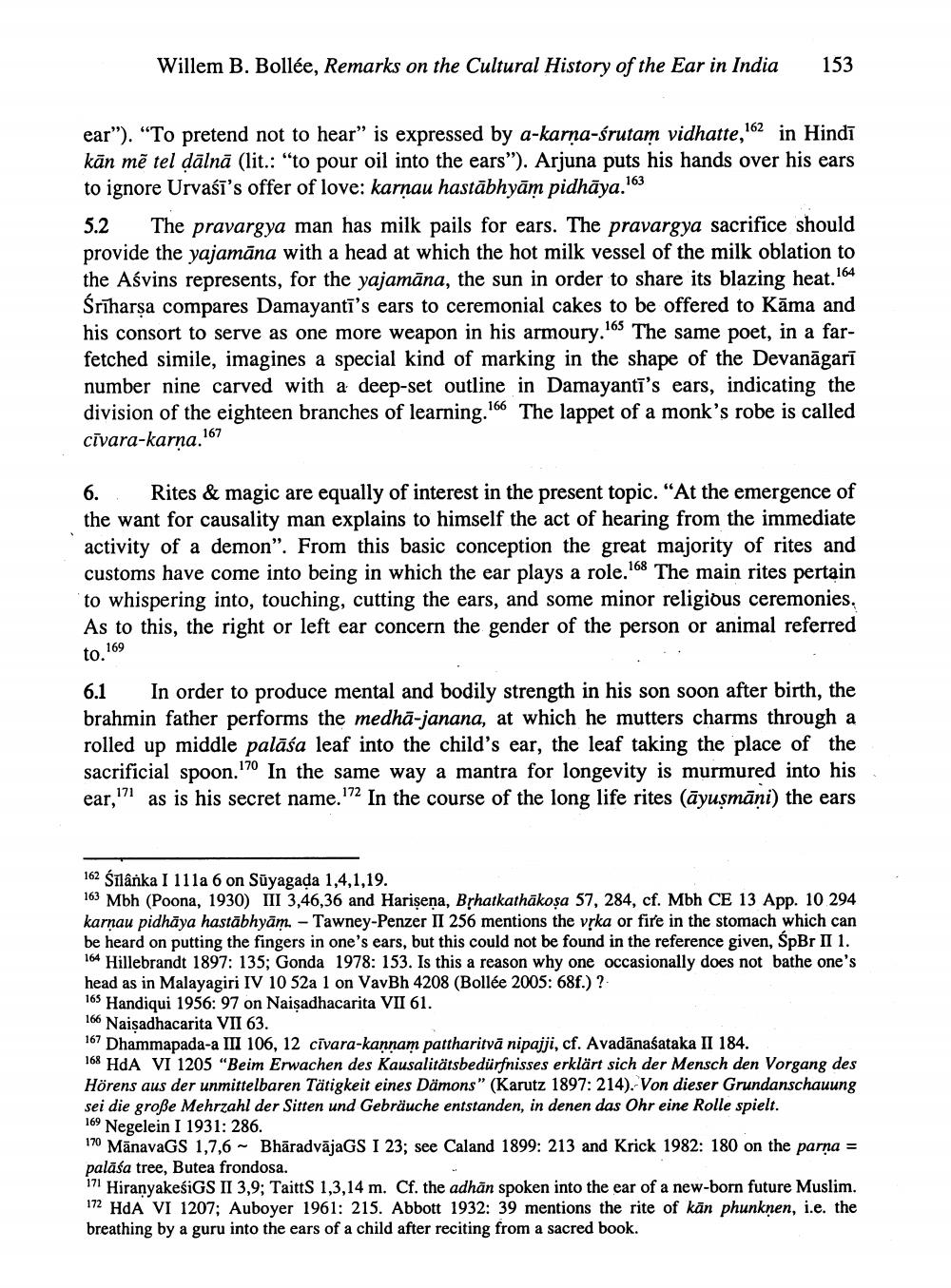________________
Willem B. Bollée, Remarks on the Cultural History of the Ear in India
153
ear"). “To pretend not to hear" is expressed by a-karņa-śrutam vidhatte,162 in Hindi kān mē tel dālnā (lit.: "to pour oil into the ears"). Arjuna puts his hands over his ears to ignore Urvasī's offer of love: karnau hastābhyām pidhāya.163 5.2 The pravargya man has milk pails for ears. The pravargya sacrifice should provide the yajamāna with a head at which the hot milk vessel of the milk oblation to the Aśvins represents, for the yajamāna, the sun in order to share its blazing heat.164 Srīharsa compares Damayanti's ears to ceremonial cakes to be offered to Kāma and his consort to serve as one more weapon in his armoury. 169 The same poet, in a farfetched simile, imagines a special kind of marking in the shape of the Devanāgarī number nine carved with a deep-set outline in Damayanti's ears, indicating the division of the eighteen branches of learning. 166 The lappet of a monk's robe is called cīvara-karņa.167
6. Rites & magic are equally of interest in the present topic. "At the emergence of the want for causality man explains to himself the act of hearing from the immediate activity of a demon". From this basic conception the great majority of rites and customs have come into being in which the ear plays a role.168 The main rites pertain to whispering into, touching, cutting the ears, and some minor religious ceremonies, As to this, the right or left ear concern the gender of the person or animal referred
to. 169
6.1 In order to produce mental and bodily strength in his son soon after birth, the brahmin father performs the medhā-janana, at which he mutters charms through a rolled up middle palāśa leaf into the child's ear, the leaf taking the place of the sacrificial spoon.170 In the same way a mantra for longevity is murmured into his ear,171 as is his secret name.172 In the course of the long life rites (āyuşmāni) the ears
162 Śtlânka I 111a 6 on Sūyagada 1,4,1,19. 163 Mbh (Poona, 1930) III 3,46,36 and Harişena, Brhatkathākosa 57, 284, cf. Mbh CE 13 App. 10 294 karnau pidhāya hastābhyām. - Tawney-Penzer II 256 mentions the vrka or fire in the stomach which can be heard on putting the fingers in one's ears, but this could not be found in the reference given, SpBr II 1. 164 Hillebrandt 1897: 135; Gonda 1978: 153. Is this a reason why one occasionally does not bathe one's head as in Malayagiri IV 10 52a 1 on VavBh 4208 (Bollée 2005: 68f.)? 165 Handiqui 1956: 97 on Naişadhacarita VII 61. 166 Naisadhacarita VII 63. 167 Dhammapada-a III 106, 12 cīvara-kannam pattharitvā nipajji, cf. Avadānaśataka II 184. 168 HDA VI 1205 "Beim Erwachen des Kausalitätsbedürfnisses erklärt sich der Mensch den Vorgang des Hörens aus der unmittelbaren Tätigkeit eines Dämons" (Karutz 1897: 214). Von dieser Grundanschauung sei die große Mehrzahl der Sitten und Gebräuche entstanden, in denen das Ohr eine Rolle spielt. 169 Negelein I 1931: 286. 170 MānavaGS 1,7,6 - BhāradvājaGS I 23; see Caland 1899: 213 and Krick 1982: 180 on the parņa = palāśa tree, Butea frondosa. 171 HiranyakesiGS II 3,9; TaittS 1,3,14 m. Cf. the adhān spoken into the ear of a new-born future Muslim. 172 HDA VI 1207; Auboyer 1961: 215. Abbott 1932: 39 mentions the rite of kan phunknen, i.e. the breathing by a guru into the ears of a child after reciting from a sacred book.




